As businesses seek to enhance their online visibility and climb the ranks of search engine results, the question arises: Can social media play a pivotal role in elevating SEO rankings? Delving into this inquiry leads us to explore the intricate dynamics of link building, dissecting how social media emerges as a platform for audience growth and a potent tool in the SEO arsenal.
This article navigates the interplay between link building and social media, unraveling the symbiotic relationship that holds the potential to shape the digital destinies of businesses in the competitive landscape.
Here’s what we’ll cover:
What is a social profile (backlinks)?
Social backlinking has emerged as a crucial strategy, seamlessly integrating the power of social media into the intricate web of link building. Let’s delve into the core aspects of understanding social backlinking and how they can significantly impact your online presence.
Definition of social media backlinks
Social media backlinks refer to the links originating from various platforms that lead users to your website. These virtual connectors are pivotal in enhancing visibility, driving traffic, and establishing credibility.
Platforms for social backlinks
Strategically placing social backlinks involves leveraging different elements across multiple social media platforms. Whether integrating links within posts, comments, or user profiles, optimizing these placements enhances the chances of attracting valuable traffic and engagement.
Direct sharing on popular platforms
Actively sharing your content on well-known social media platforms such as Twitter, Facebook, and Pinterest creates prime opportunities for backlinks. This direct engagement amplifies your content’s reach, fostering a broader audience and increasing the potential for social media-driven link building.
Steps to improve your social backlink profile
Enhancing your social backlink profile involves a strategic approach that combines the strengths of your website content and social media presence. Follow these steps to optimize your social backlinking strategy:
1. Check your website content and social media profiles
Inclusion of website links in social media profiles
Ensure that your social media profiles feature direct links to your website. Whether it’s your personal profile, business page, or group account, having accessible links amplifies the chances of generating valuable backlinks.
Posting website content on social media
Actively share high-quality content from your website across all social media platforms. This increases your content’s visibility and creates opportunities for organic backlinks as users engage with and share your valuable content.
Updating and optimizing profiles on various social media platforms
Regularly check and update your profiles on different social media platforms. Verify that each profile includes accurate information and a functional link to your website. Consistency across platforms enhances the overall coherence of your online presence.
Maximizing visibility through strategic link placements
Strategically place links within your social media content, including posts, comments, bios, and descriptions. Optimize cover photos, images, and other visual elements with clickable links. This thoughtful approach ensures maximum visibility and increases the likelihood of attracting backlinks.
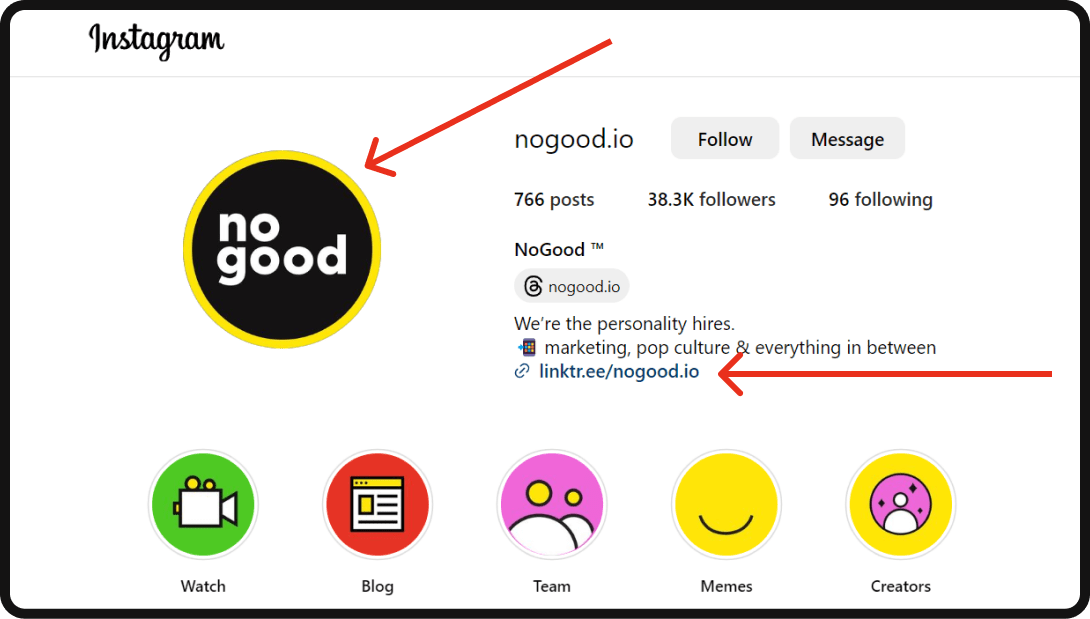
Crafting content that naturally attracts social backlinks is a strategic move in bolstering your online presence. Here are key steps to ensure your content is engaging and inherently link worthy:
Importance of quality content for social backlinking
Quality serves as the cornerstone of effective social backlinking. Compelling, informative, and valuable content resonates with your audience and entices them to share and link back. Prioritize substance over quantity to establish credibility in your niche.
Focus on evergreen content and trending topics
Strike a balance between timeless evergreen content and current trending topics. Evergreen content maintains relevance over time, consistently attracting backlinks. Simultaneously, tapping into trending topics capitalizes on current discussions, increasing the likelihood of sharing and link building.
Take a look at this TikTok, where we struck a balance between evergreen content and a trending topic.
@nogood.io no one: the old snapchat ghost: 😋 #tech #techtok #graphicdesign #logo #logos #socialmedia #icons ♬ original sound – NoGood
Utilizing “how-to” content for effective engagement
Guide your audience with practical “how-to” content. This format effectively provides value, solves problems, and garners social shares. Users often link to instructional content, recognizing its utility and sharing it with their networks.
Pinning important content for increased visibility
Leverage platform features to pin essential content to the top of your feed. Doing so ensures that critical information or particularly link-worthy content remains prominently displayed. This enhances visibility and increases the chances of garnering backlinks over time.
Need additional SEO guidance?
3. Finding & using the right keywords
Optimizing your social backlinking strategy involves strategic keyword usage. Understanding your audience and leveraging relevant language is crucial for success. Here’s how to integrate keywords effectively:
Audience understanding and language relevance
Connect with your audience by comprehending their language and preferences. Conduct thorough audience research to identify the words and phrases they commonly use. Aligning your content with their language fosters a sense of relatability, increasing engagement and the likelihood of attracting valuable backlinks.
You can find this information using various tools, including Ahrefs or Google Analytics. Simply use your domain as a starting point and head to the “traffic by location” section to better understand your audience’s language preferences.
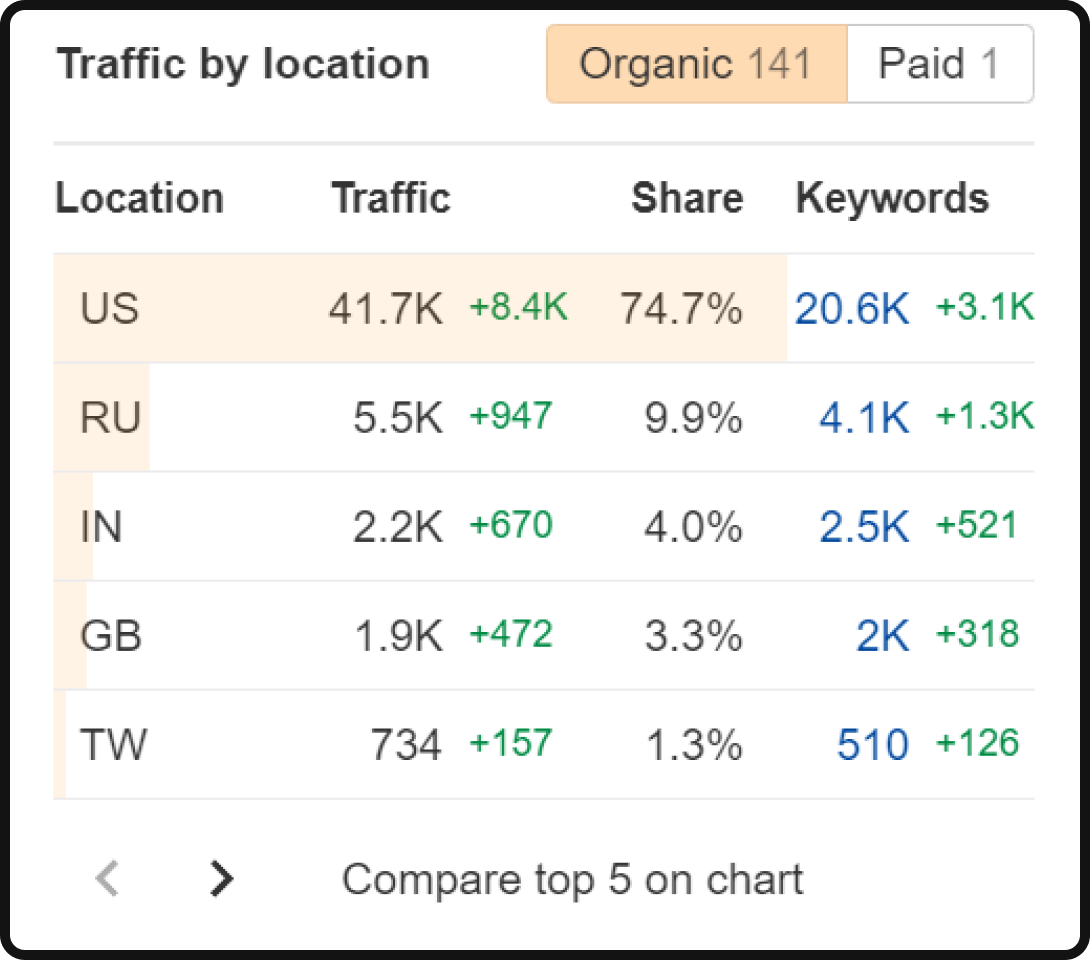
* Side note: We’ll dive deeper into keyword research for specific social media platforms later in this article.
Content creation based on targeted keywords
Craft content around targeted keywords that resonate with your audience. Use these keywords naturally within your posts, captions, and comments. This enhances your content’s discoverability and aligns it with the search terms your audience will likely use, increasing the chances of receiving social backlinks.
If you’re using Ahrefs or SEMrush to do keyword research, you can head to the organic keywords or content gap section to find a list of keywords that will resonate with your audience.
Building links through increased likes and comments
Encourage audience interaction through likes and comments. Engaging content naturally elicits responses. This audience interaction will not only boost the visibility of your content within social media algorithms, but create opportunities for backlinks. Actively respond to comments to foster a community that is more likely to share and link to your content.
4. Creating trendy content
Staying on the pulse of current trends is a dynamic strategy to boost your social backlinking efforts. Here’s how to create content that not only aligns with the latest trends, but enhances your brand’s visibility:
Leveraging current trends for increased visibility
Keep a watchful eye on what’s trending across social media platforms. By incorporating these trends into your content, you tap into a larger audience actively engaging with popular topics. Trendy content is more likely to be shared, increasing its visibility and, consequently, the potential for garnering valuable social backlinks.
Offering valuable insights into trending topics
Don’t just follow trends; provide meaningful insights. Share your perspective on trending topics within your industry or niche. Offering valuable commentary establishes your brand as an authoritative voice, attracting more attention and increasing the likelihood of your content being shared and linked.
Aligning content with brand relevance and avoiding harmful trends
While capitalizing on trends is beneficial, ensure the content aligns with your brand values and relevance. Avoid jumping on trends solely for popularity if they contradict your brand identity. Choose trends that resonate positively with your audience, steering clear of any potentially harmful associations that may impact your brand reputation.
5. Leverage customer reviews
Harnessing the power of customer reviews can significantly contribute to your social backlinking strategy. Here’s how to leverage customer feedback to enhance engagement and trust:
Social proof through customer reviews
Customer reviews serve as powerful social proof, showcasing real experiences with your brand. Encourage satisfied customers to share their thoughts on social media platforms. These authentic testimonials act as compelling endorsements, influencing potential customers and, in turn, contributing to your social backlink profile.
Enhancing engagement and trust through reviews
Customer reviews not only provide valuable feedback, but contribute to increased engagement and trust. Actively respond to reviews, expressing gratitude for positive feedback and promptly addressing concerns. This engagement fosters a sense of trust among your audience and encourages them to share and link to your content.
Strategies to encourage and manage customer reviews
Implement strategies that encourage customers to leave reviews. Send post-purchase emails requesting feedback or create incentives like discounts for reviews. Additionally, actively manage reviews by monitoring various review platforms and swiftly addressing customer concerns. Proactively showcasing positive reviews on social media platforms boosts your online reputation and creates opportunities for social backlinks from satisfied customers.
6. Connect with bloggers and brands in your niche
Forging connections with influencers, bloggers, and brands within your niche is a strategic move to bolster your social backlinking efforts. Here’s how to navigate and maximize these connections:
Building relationships with influencers in the niche
Identify key influencers and thought leaders in your niche and initiate genuine interactions. Follow them on social media, engage with their content, and contribute to relevant discussions. Building authentic relationships with influencers expands your network and opens doors for potential collaborations and social backlink opportunities.
Guest posts, content mentions, and exchanges
Establishing connections can lead to valuable opportunities for social media link building. Explore options such as guest posting on platforms, receiving content mentions, or engaging in link exchanges. These collaborations diversify your backlink profile and expose your content to a broader audience.
Another way to gain content mentions is to use the ego bait strategy. As the name implies, you’ll first mention high-quality brands or influencers in your niche in a positive light. From there, the individuals mentioned will likely reshare your content in order to promote their own platforms.
Take a look at this LinkedIn post, where we positively mentioned other brands in our post:
Effective communication strategies via social media and email
Master the art of effective communication to maximize link-building opportunities. Engage influencers through thoughtful comments, direct messages, or mentions on social media platforms. In addition, use email communication for formal collaboration proposals. Personalize your outreach, clearly articulate mutual benefits, and be respectful of your recipients’ time to increase the likelihood of successful social backlink partnerships.
7. Use graphics and video content
Elevating your social backlinking game involves strategically focusing on visually appealing content. Here’s how incorporating graphics and videos enhances engagement and increases the likelihood of being featured in others’ content:
Visual appeal and engagement through graphics and videos
Capture your audience’s attention with visually stunning graphics and engaging videos. Visual content has a higher retention rate and encourages more social shares. Leveraging these elements enhances your content’s appeal and increases the probability of others incorporating your visuals into their content.
Effectiveness of cartoons, illustrations, and infographics
Cartoons, illustrations, and infographics are highly shareable and digestible forms of content. They convey information in a visually appealing way, making them ideal for social media consumption. Crafting shareable graphics increases the chances of your visuals being used in others’ content, leading to valuable backlinks.
Importance of videos
Videos, particularly on platforms like Facebook, are powerful tools for engagement. Native videos on Facebook, for instance, are significantly more likely to be shared. The shareability of videos increases the likelihood of your content being featured in others’ posts or articles, contributing to the growth of your social backlink profile.
Creating visually striking graphics and compelling videos enhances the chances of others finding your content share worthy. As they incorporate your visuals into their content, you enhance your brand’s visibility and gain valuable backlinks from diverse sources.
For reference, take a look at Facebook video viewing habits:
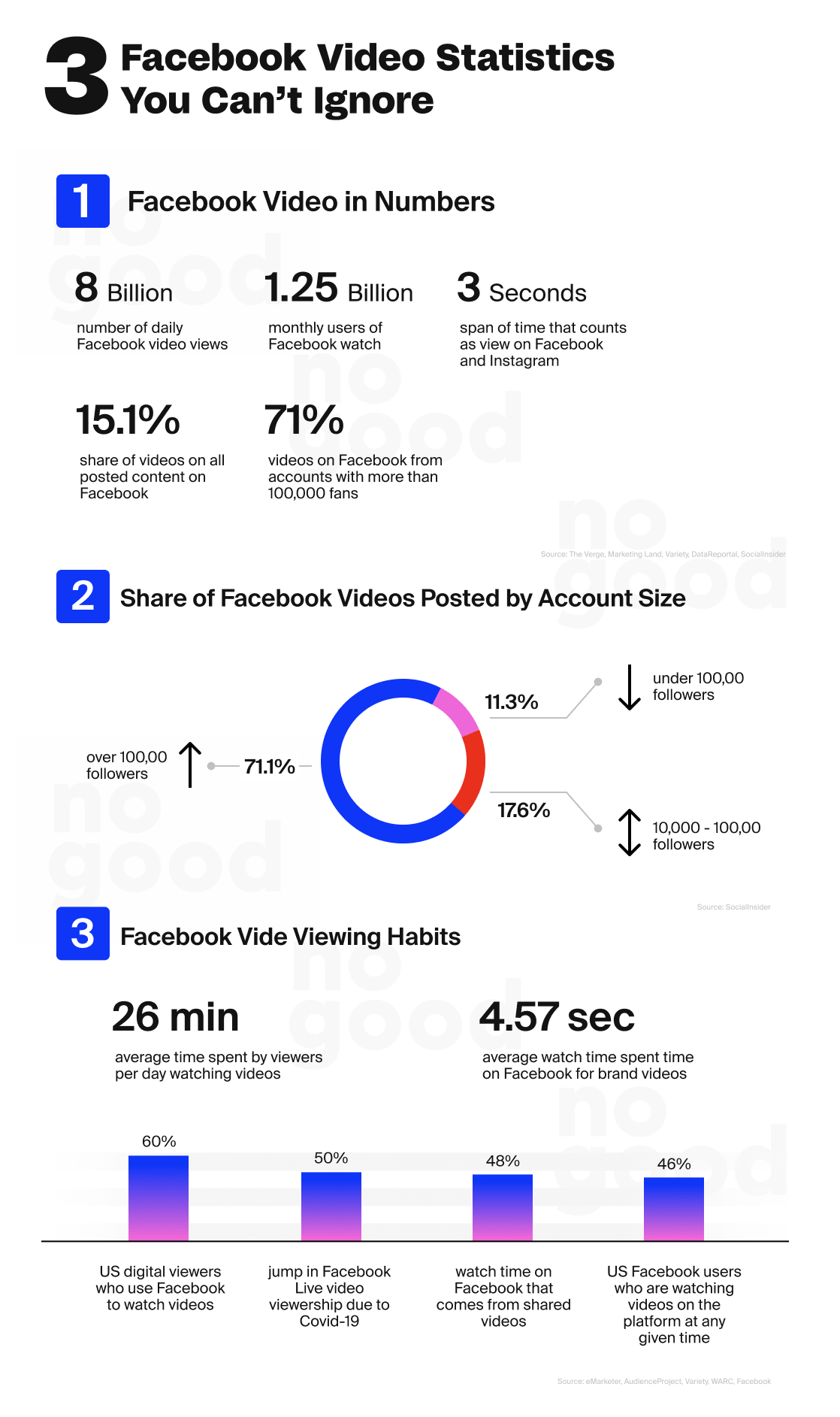
8. Incorporate Hashtags
Effectively utilizing hashtags in your social media strategy can significantly boost content visibility and foster connections with journalists and bloggers. Here’s how to leverage the power of hashtags for social backlinking:
Significance of hashtags in social media search
Hashtags serve as digital signposts, guiding users through the vast landscape of social media content. When users search for specific topics, relevant hashtags act as a beacon, leading them to content aligned with their interests. Understanding the significance of hashtags in social media searches is crucial for enhancing your content’s discoverability.
Utilizing relevant hashtags
Integrate carefully chosen and relevant hashtags into your social media posts. Research popular hashtags within your niche and incorporate them strategically. This practice enhances the visibility of your content to a wider audience and positions it for potential inclusion in trending discussions, increasing the chances of social backlinks.
Connecting with journalists and bloggers
Many journalists, bloggers, and content creators actively use hashtags to source information and discover new trends. By aligning your content with popular hashtags, you optimize the probability of capturing these professionals’ attention. Engage with journalists and bloggers by participating in relevant hashtag conversations, providing valuable insights, and positioning yourself as an industry resource.
Incorporating hashtags into your social media strategy is not just about visibility—it’s a strategic way to connect with creators, who may find your content valuable and link worthy. The right hashtags can serve as bridges, elevating your content to new heights and generating meaningful social backlinks.
Now that we’ve discussed general best practices to gain quality backlinks on social media, let’s look at specific methods for each platform.
Using specific social media platforms for link-building
With its visually rich platform, Instagram offers unique opportunities for social backlinking. Elevate your Instagram strategy with these techniques to maximize backlink potential:
Instagram SEO keywords in captions
Incorporate SEO-driven keywords into your Instagram captions to enhance discoverability. Utilize free SEO tools such as Google Analytics or Google Trends to identify relevant keywords for your content, and leverage Instagram’s search bar for real-time keyword discovery. By understanding the search terms used among your audience, you increase the chances of your posts appearing in relevant search results.
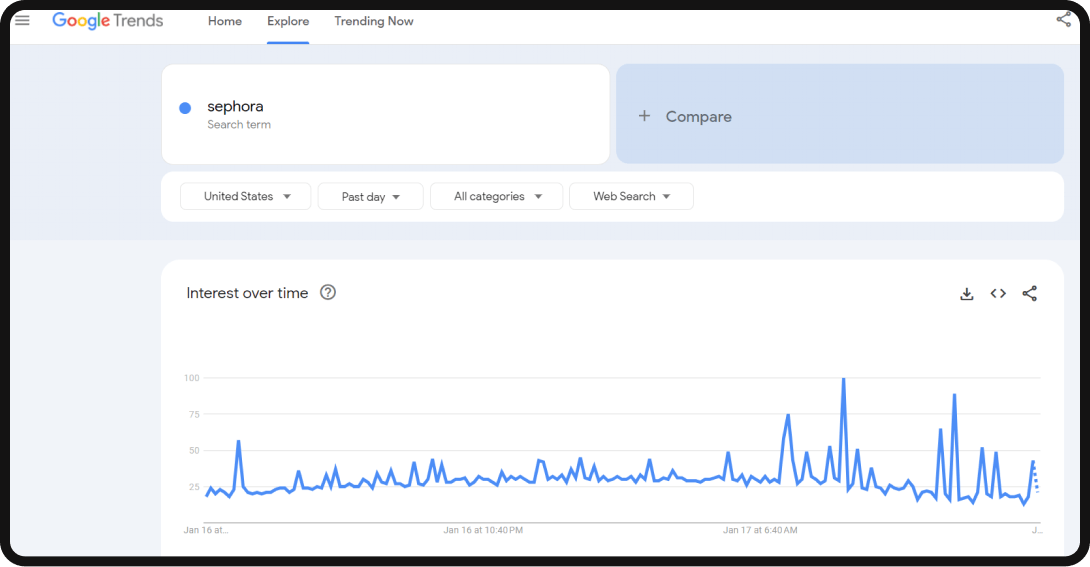
SEO-driven hashtags for visibility
Strategically use hashtags to boost your content’s visibility. Follow Instagram’s guidelines by using a mix of well-known, niche, and specific hashtags, and limit each post to 3 to 5 hashtags to ensure relevance. Instagram Insights provides valuable data about which hashtags drive traffic to your posts. Social listening and the Instagram search bar aid in discovering trending hashtags within your niche. Place hashtags directly in the caption for optimal search impact.
Alt text for SEO enhancement
Optimize your content for accessibility and search engines by using alt text. Instagram’s automatic alt text may lack detail, so enhance it with human-created alt text. When posting a photo, scroll to Advanced settings and add a detailed description incorporating relevant keywords. Follow Instagram’s alt text recommendations, including providing context about objects, concepts, and locations. Alt text enhances accessibility and SEO within Instagram’s algorithm and regular search engines.
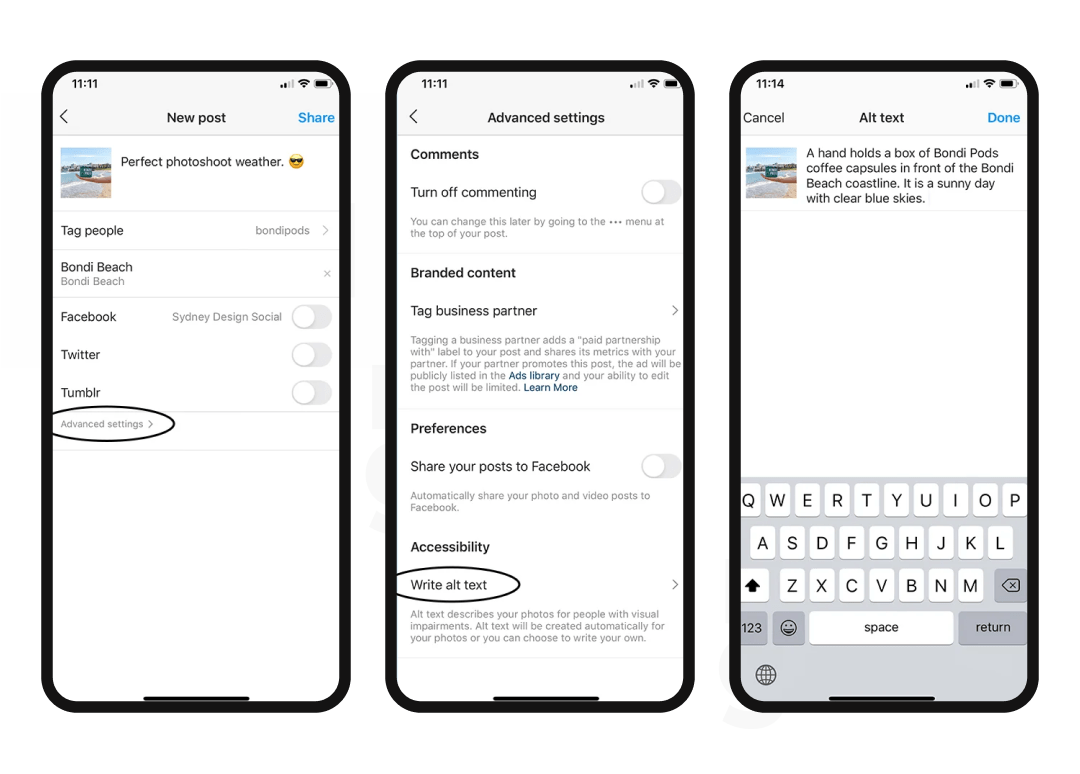
Video subtitles for SEO context
Maximize the SEO potential of videos by adding subtitles. Instagram’s auto-generated subtitles serve accessibility, but incorporating target keywords enhances SEO context. This provides search crawlers with detailed insights into your video’s content. Detailed captions improve your video’s discoverability within Instagram and regular search engine results.
Engage with accounts ranking for keywords
Boost your Instagram presence by engaging with accounts that are already ranking for your target keywords. This helps Instagram understand your account’s niche and encourages reciprocal engagement. Engagement is a vital popularity ranking signal, offering a dual benefit of improving your ranking factors and fostering connections within your niche.
Optimize Instagram bio for context
Leverage your Instagram bio to provide context for both users and search engines. Clearly communicate who you are, your content focus, and visitors’ expectations. This concise description aids the Instagram search engine in understanding your account’s relevance, making it more likely to appear in related search results.
Harness the power of Facebook for effective social backlinking by implementing these strategies tailored to the platform:
Add a link to your Facebook profile bio
Optimize your personal profile by adding a backlink to your website. Utilize the intro or bio section, ensuring your URL includes “http://” or “https://.” This quick backlink enhances your Facebook presence for social media link building.
Put a link on your business page
Create a business page and strategically place a link in the “About” section under “Contact Information.” This presents an opportunity for a valuable backlink on your Facebook business page, contributing to your social media link-building efforts.
Build links through Facebook posts
Utilize your personal timeline or business page for link-building through posts. Incorporate backlinks in two ways:
- Link in the status update: Place your link within the first sentence for maximum visibility.
- Link in a photo caption: Enhance engagement by including backlinks in photo descriptions.
Create links In Facebook comments
Expand your website’s exposure by creating backlinks in other users’ Facebook comments, particularly within relevant Facebook groups. Ensure compliance with group rules and seek permission when needed. This strategy fosters content visibility and relationship building within your niche.
Connect with other site owners in messenger
Leverage Messenger to connect with fellow bloggers and business owners. Collaborate on guest posts, link insertions, or editorial links. Building relationships through Messenger proves more successful than traditional cold outreach, enhancing your chances of acquiring valuable backlinks.
Use Facebook ads to build links
Capitalize on Facebook Ads to widen your content’s reach and secure organic backlinks. Target specific demographics and interests to reach the right audiences. Running ads for new blog posts can increase content visibility, attracting potential linkers. Additionally, utilize custom audiences to reach individuals already interested in your content.
Quora
Quora, while not a traditional social media platform, holds substantial value for link building when approached strategically. Here’s a guide to incorporating Quora into your link-building strategy:
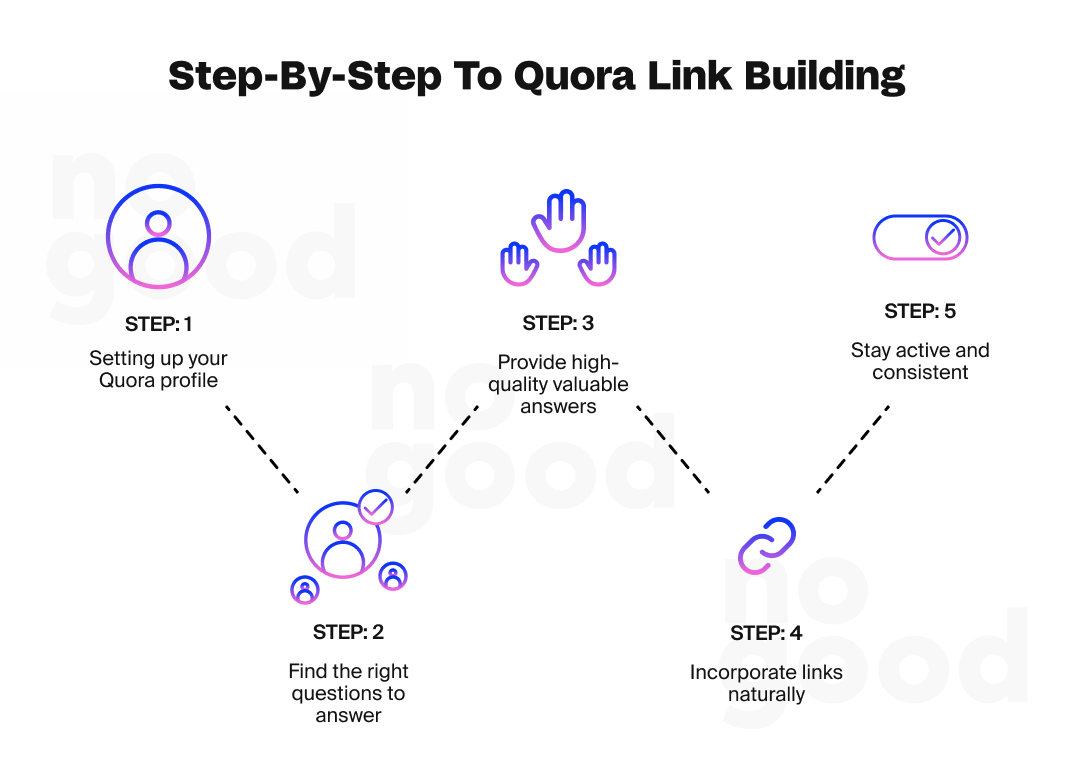
Prerequisites for Quora success
Before diving in, ensure you have:
- In-depth content on your website: Compelling content is the magnet that attracts Quora users to explore your website.
- Time commitment: Building a presence on Quora requires time and consistent effort. Cultivate credibility as Quora values depth of engagement.
Answering questions on Quora
- Finding questions to answer
- Click on “Answer” in the top bar to locate relevant questions. Alternatively, you can just search Quora using the keywords you know are valuable to your target audience.
- Opt for questions where you can provide genuinely helpful insights.
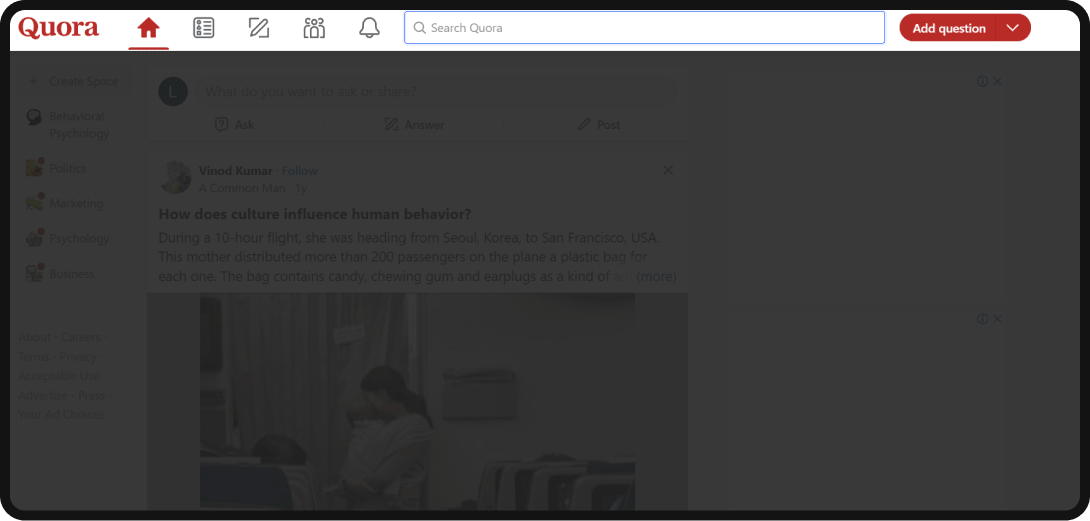
- Crafting effective answers
- Write step-by-step answers.
- Adopt a conversational tone.
- Incorporate images where possible.
- Utilize Quora’s formatting options, including text formatting, images, quotes, and more.
Linking to your blog/ website in answers
- Strategic linking:
- Link to your blog articles within your Quora answers strategically.
- Select the most relevant blog article based on your answer.
- Creating hyperlinks:
- Copy the link to the chosen blog article.
- In your Quora answer, highlight the portion to link.
- Use the hyperlink option in the upper right corner of the answer edit pane.
- Best practices for linking:
- Limit linking to once per answer.
- Link only when necessary and natural within the context.
- Be cautious not to appear promotional; prioritize adding value.
Quora ethics and best practices
- Value-centric approach:
- Quora is about providing answers and value, not just link building.
- Align your approach with the community’s ethos of professional knowledge sharing.
- Linking guidelines:
- Link only when it enhances the answer’s value.
- Do not use Quora primarily for self promotion.
- Follow a 99% value, 1% self linking rule to maintain credibility.
- Examples of linking:
- Good example: “For an example of creating long-form blog posts, check out this step-by-step guide.”
- Bad example: “Visit my blog for amazing content!”
Adhering to Quora’s strict moderation policies ensures sustained success. Prioritize delivering value; the resulting strong personal brand and referral traffic will naturally follow.
Unlocking the full potential of Twitter for effective link building involves optimizing your profile, leveraging retweets, getting verified, running contests, and partnering with influencers. Here’s your comprehensive guide:
Optimizing your Twitter profile
- Bio enhancement:
- Fill out your bio with relevant keywords.
- Highlight your best content and include a link to your website.
- Craft a strong header image with content headlines for enhanced clicks.
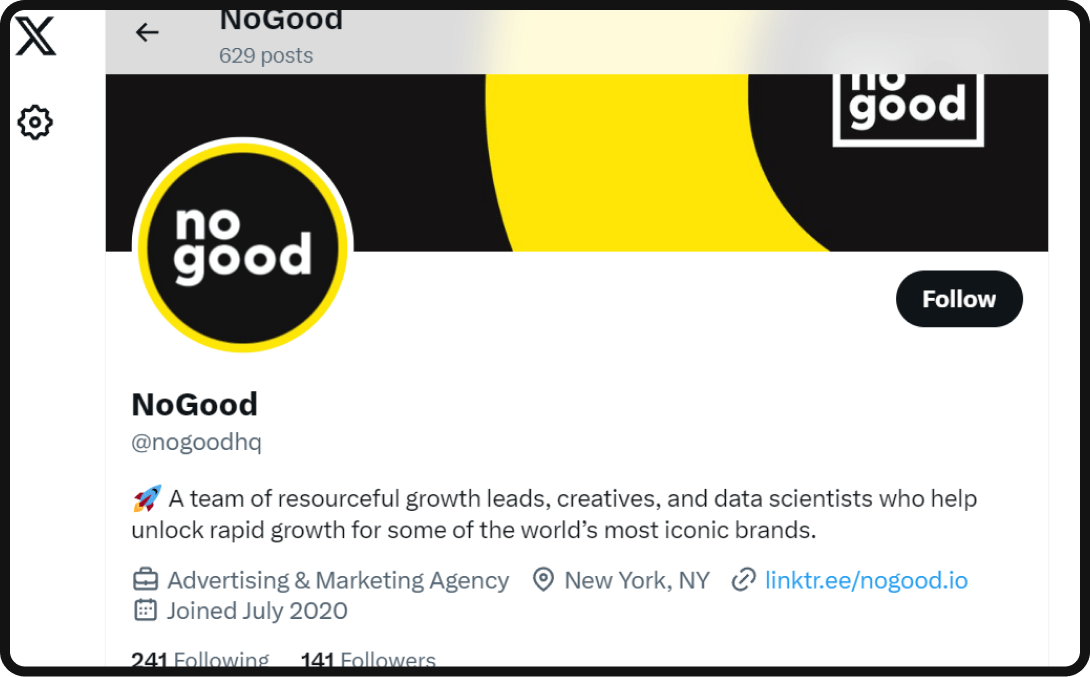
- Profile imagery:
- Use a high-quality and brand-consistent profile photo.
- Set up Twitter cards for rich content previews when shared.
- Monitoring profile views:
- Actively work to increase profile views through engagement.
- Increased profile views often lead to more link clicks.
Encouraging retweets for backlinks
- Quality content:
- Post valuable and engaging content that followers will want to retweet.
- Leverage visuals, such as images and videos, for higher retweet rates.
- Strategic Tweet timing:
- Study when your followers are most active and post during peak times.
- Utilize relevant hashtags without over-optimizing.
- Engagement with influencers:
- Mention influencers in your niche to incentivize shares.
- Reward top retweeters with contests or amplify their content.
Verification for credibility
- Verification benefits:
- Adds credibility and authority to your brand.
- Increases profile views, engagement, and visibility.
- Verification tips:
- Have an established and active presence on and off Twitter.
- Use your official brand name consistently.
- Opt for a professional profile with proof of identity.
Running effective Twitter contests
- Contest formats:
- Photo contests, caption contests, content contests, hashtag contests, blog giveaways, and AMAs.
- Ensure entries are submitted on your owned platforms for backlinks.
- Promotion strategies:
- Promote contests organically on Twitter and through paid ads.
- Incentivize sharing and participation with compelling prizes.
Partnering with influencers
- Identifying influencers:
- Look for accounts with high follower counts, impressive engagement, and similar target audiences.
- Micro-influencers with engaged audiences can be valuable partners.
- Encouraging influencer links:
- Guest post outreach, giveaways, curated lists, expert quotes, co-created content, product seeding, and sponsorships.
- Focus on providing value and cultivating mutually beneficial partnerships.
Additional strategies and tips:
- Content variety:
- Share diverse content types to attract different audiences.
- Amplify your best content through periodic repurposing.
- Rewarding loyalty:
- Acknowledge and thank regular content sharers.
- Consider sharing their content or offering discounts as a token of appreciation.
- Visual appeal:
- Create eye-catching visuals, as tweets with images see more retweets.
- Utilize tagged lists for earning pick-up links.
- Quoting influencers:
- Select relevant statistics or quotes shared directly by influencers.
- Guide followers to your content for additional context.
- Bio optimization:
- Feature your best content offer in the valuable link slot in your bio.
- Change it periodically to keep it fresh.
- Pinning important tweets:
- Pin tweets that you want more people to see and link to.
- Ensure these tweets showcase your best and most relevant content.
Mastering link-building on Twitter involves a multifaceted approach, combining profile optimization, engagement strategies, contests, influencer partnerships, and ongoing content promotion. Tailor these techniques to your brand and audience for optimal results.
To harness the full link-building potential of LinkedIn, employ these strategic approaches tailored for the professional networking platform:
Publish quality content
- Craft content aligned with your niche expertise, such as blog posts or videos.
- Ensure relevance to attract shares, establishing authority in your industry.
- For instance, an SEO expert can share insights on the latest trends or offer optimization tips.
Build authentic professional contacts
- Leverage LinkedIn’s business-centric environment for networking.
- Send personalized connection requests to individuals interested in your field.
- Authentic connections become valuable when seeking linkbacks or collaboration opportunities.
Participate in relevant LinkedIn groups
- Join industry-specific groups to engage with professionals and leverage their authority.
- Contribute thoughtfully in discussions, avoiding overt promotion.
- Gain recognition as an expert, making others more likely to follow your shared links.
Share content via member-to-member communications
- Actively engage with other members by liking, commenting, and sharing relevant content.
- Build relationships and showcase industry expertise through thoughtful content sharing.
- Include links in shared content to encourage backlinks to your profile or website.
Create informative videos
- Leverage LinkedIn’s video feature to share industry-related content.
- Focus on clear, informative videos that viewers find valuable.
- Tag relevant accounts and provide links in the video description for potential backlinks.
Put links in your posts
- Craft quality LinkedIn posts with links to your website or blog.
- Widen your audience, attracting potential backlinks from interested readers.
- Engage with others on the platform, participate in discussions, and join relevant groups for increased visibility.
Direct outreach for backlinks
- Reach out to other websites in your industry through email or social media.
- Politely inquire about including a link back to your site on their platform.
- Direct outreach can lead to valuable backlinks, enhancing your website’s authority.
Combining these strategies allows you to optimize your LinkedIn presence for effective link building, establish authority within your industry, and drive quality website traffic.
Looking for more LinkedIn guidance? Check out our article on the best marketing experts to follow on LinkedIn in 2024.
How to track your social backlinking efforts
Tracking your social backlinking efforts is crucial to understanding the impact of your strategy and making informed decisions. Here’s a step-by-step guide on effectively tracking your social backlinking efforts:
- Set clear goals:
- Define specific goals for your social backlinking efforts, such as increased website traffic, improved search rankings, or enhanced brand visibility.
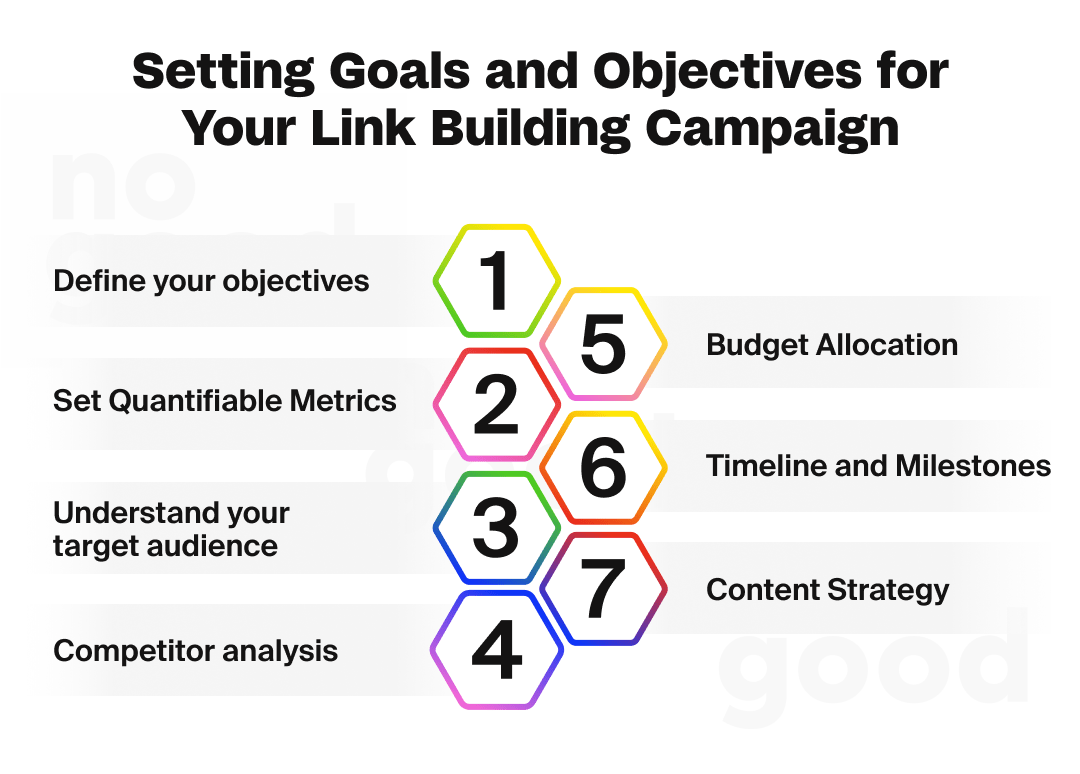
- Use analytics tools:
- Leverage analytics tools like Google Analytics to monitor website traffic originating from social media platforms. Track the referral traffic and identify which social channels drive the most visitors.
- Monitor social media insights:
- Utilize built-in analytics features on social media platforms. Platforms like Facebook, Twitter, and LinkedIn provide insights into post performance, engagement, and click-through rates. Track the links shared and their impact.
- Custom UTM parameters:
- Implement custom UTM parameters when sharing links on social media. This lets you track the source, medium, and campaign associated with each link in Google Analytics, providing detailed insights into social media-driven traffic.
- Example of a UTM link: www.yourwebsite.com/page?utm_source=facebook&utm_medium=social&utm_campaign=social_backlinking
- Track social shares:
- Monitor the number of social shares for your content. This metric reflects the reach and engagement of your posts. Tools like BuzzSumo or native social media analytics can help track share counts.
- Backlink monitoring tools:
- Set up alerts:
- Set up alerts or notifications for brand mentions and backlinks using tools like Google Alerts or Mention. This ensures you know new links and can assess their impact on your website.
- Track rankings:
- Monitor your search engine rankings for targeted keywords. An improvement in rankings can be an indicator that your social backlinking strategy is effective.
- Engagement metrics:
- Evaluate engagement metrics on social media, such as likes, comments, and shares. Higher engagement often correlates with increased visibility and the potential for more backlinks.
- Conversion tracking:
- Implement conversion tracking in Google Analytics to understand the impact of social backlinks on specific actions such as form submissions, purchases, or other desired outcomes.
- Regular reporting:
- Generate regular reports to analyze the performance of your social backlinking efforts. Identify trends, successes, and areas for improvement.
- A/B testing:
- Conduct A/B testing with different social media strategies to understand what content or approaches generate the most backlinks and engagement.
By systematically tracking these metrics, you’ll gain valuable insights into the effectiveness of your social backlinking efforts and be better equipped to refine your strategy for optimal results.
Final thoughts
The symbiotic relationship between social media and link building is a formidable force in the digital landscape. Dynamic platforms offer powerful avenues for fostering immediate results through increased visibility and engagement and nurturing the seeds of long-term brand growth. Striking a delicate balance between these two objectives is key, ensuring that the allure of immediate gains does not overshadow the enduring benefits of organic link-building.
Establishing trust and authority over time becomes the linchpin for a robust link-building strategy, with social media catalyzing connection formation, fostering engagement, and solidifying a brand’s position in the ever-evolving digital ecosystem. As brands navigate the intricate web of link building, a strategic and holistic approach that intertwines social media dynamics with the pursuit of enduring credibility emerges as the pathway to sustained success.




